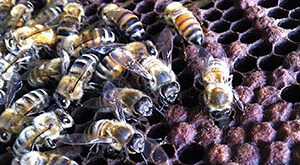Science Insider
The Surprisingly Sophisticated Ways that Honey Bees Fight Disease

Honey bees can’t socially distance. Here’s what they do instead
The air is warm with bodies and heavy with humidity. Nestmates huddle and rapidly antennate one another, as if they’re chatting, sharing pheromones, information, and food. Living in a beehive is like living in a house with 40,000 siblings who have no concept of personal space. Honey bees can’t socially distance; rather, their very existence depends on social cohesion.
Colonies are a pathogen’s dream, and opportunities to spread from bee to bee and colony to colony abound. Accordingly, honey bees’ disease-prevention strategies are far more elaborate than simply staying away from each other when they’re sick. Millions of years of disease pressure has incrementally driven honey bees to gain surprisingly sophisticated disease-fighting strategies. They even have corollaries to hand-washing, medicine, vaccines, and quarantine.
Prevention first
The best strategies are those that halt an outbreak before it begins. For example, honey bees collect antimicrobial plant resins to coat the inside of the hive, with a special focus on the entrance. Much like the hand sanitizer at the door to the grocery store, this sticky substance, propolis, acts like a disinfectant for the tarsi (feet) of foragers, who are forced to walk over it as they return home from the risky, pathogen-sprinkled outside world. Indeed, the term “propolis” has Greek origins meaning before (pro) the city (polis), after early observations of honey bees building curtains of resin at their doorways.
But the power of propolis doesn’t stop there. Propolis is not only antibacterial, it’s also antifungal and antiviral, owing to the complex phytochemicals in tree resins. And when colonies catch chalkbrood — a fungal pathogen, Ascosphera apis, which mummifies larvae from the inside out — foragers will scout out more of the fungus-fighting resin from trees like cottonwood and poplar.1 It’s like going out to stock up on medicine when the kids get sick.
Dr. Renata Borba, who conducted her PhD research at the University of Minnesota and is currently the Alberta Beekeepers Tech Transfer Team leader, confirmed that the propolis envelope helps fight against American foulbrood, a bacterial disease, as well.2 Curiously, she found that the brood food in colonies with a propolis envelope had higher antimicrobial activity than in colonies without. It’s not clear if the antimicrobial compounds from propolis were making their way into the brood jelly, or if propolis stimulated nurses to secrete their own bactericidal molecules into the food. But either way, propolis does more than reduce the chances of bringing pathogens home — it also gives the vulnerable larvae a helpful boost to their immunity.
Dividing labor divides the risk
We don’t usually think of division of labor as being an immune defense strategy. But by having specific groups of bees do the jobs with higher risks of contracting novel diseases (foraging), while other bees stay home and look after the queen and the brood (nurses), the risk of transmitting diseases to brood is mitigated. Nurse bees are typically so young that they haven’t yet ventured outside, where they can acquire new pathogens, so they are unlikely to transmit new diseases between brood cycles.
Only later in life, having fulfilled their nursing duties, do the nurses become foragers and pass on their care-giving duties to the next cohort. This division of labor helps to prevent foragers, who might have just been robbing out another colony or foraging on contaminated flowers, from having close contact with the queen and brood. It’s as much social distancing as the bees can manage in a dense colony — keeping those with the highest likelihood of transmitting pathogens away from those who are most vulnerable.
In fact, this kind of task-specialization is one of the original ingredients in social insects’ evolutionary recipe. Place normally-solitary, ground-nesting bees together and the dominant female will lay eggs while the strongest will dig, and the meanest will defend.3 They self-organize to do the tasks to which they are best suited. Scientists think that this kind of self-organization is one of the characteristics that enabled insect societies to evolve. For honey bees, this now-entrenched cooperative segregation between caring nurses and daring foragers also creates a social buffer of disease-naïve nurses around the most susceptible larval kin.
Vaccines for all
Honey bees even have not one, but two kinds of “vaccines,” though not the kind delivered with a syringe. In essence, workers can vaccinate the larvae they care for, and queens can vaccinate the eggs they lay. As far as we know, this does not offer the bees long-term immune protection, but it protects them when they’re most vulnerable. Nurse bees act like immune surveillance systems: If they are unlucky enough to become infected with a virus, they will produce and secrete antiviral molecules — called double-stranded ribonucleic acid, or dsRNA — in the brood jelly that they feed to their baby sisters. When the larvae consume the dsRNA, they gain this transmissible immunity and become resistant to the virus too,4 without having to actually become infected by it.
Those dsRNA molecules specifically ward off the virus that the original nurse was infected with, so this approach efficiently protects the larvae against exactly the types of viruses that are circulating in the hive. That’s because the dsRNA sequence is modeled off the virus’s own genome. When a larva receives this dsRNA, the dsRNA is incorporated into the larva’s own molecular machinery, which lets it seek out and destroy sequences that look similar to the dsRNA — the virus.
A different kind of vaccination pathway, called transgenerational immune priming,5 enables the queen to transfer ….


